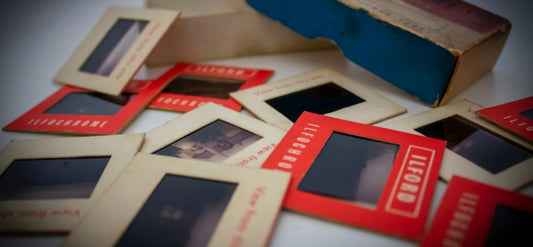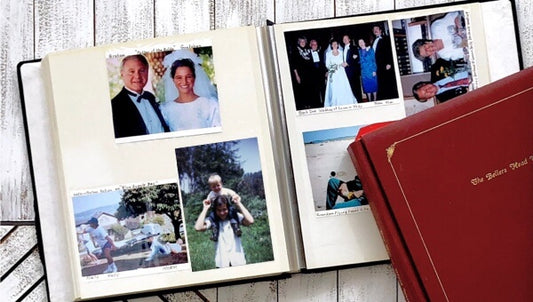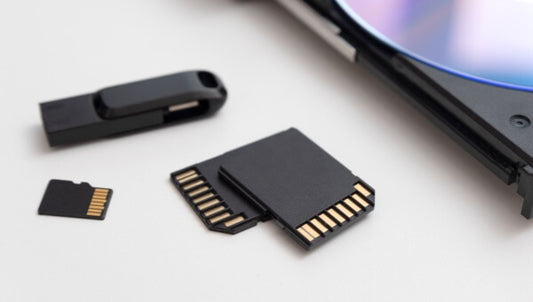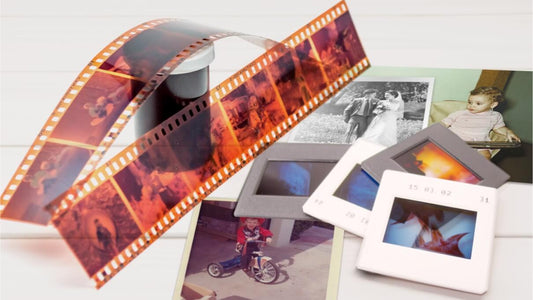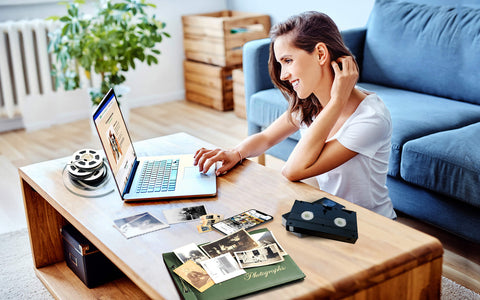While photo slides were most popular during the mid-to late-20th century, there has been a recent revival in the digital age. That’s because photo slides offer something that digital images can’t: a physical, projectable, and vintage aesthetic that evokes nostalgia.
Capture archival experts and digitization specialists want to make sure your memories survive, but we also want to make sure the history and importance of photography survive. That’s why we put together this complete guide to photo slides in 2025.
Keep reading to learn about the history and uses of photo slides, how to transition into the digital era, and possible creative uses for your old photo slides.
Jump To:
- A Brief History of Photo Slides
- Types of Photo Slides
- The Uses of Photo Slides
- Transitioning to the Digital Era
- Sharing and Preserving Photo Slides
- Reviving the Nostalgia: Modern Uses of Photo Slides
- Conclusion
A Brief History of Photo Slides
The history of photo slides begins in 1849 with lantern slides made of transparent film. This was only around a decade after the invention of photography, but the lantern slides made a clearer image. However, these were much different than the modern slides because they didn’t use a projector. Instead, lantern slides were viewed by placing them in front of a light source, such as an oil lamp, to project the image onto a wall.

Still, if you’re wondering, “What are photo slides called?”, the term transparencies originated with these original slide types that acted as the predecessors to modern slide photography.
Since the introduction of the original transparencies, there has been an assortment of other types like the 126 slides, which used a plastic frame instead of a cardboard frame, and the Ektachrome 120 medium format slides introduced in 1901 for use with the Brownie No. 2 camera.
There is also the 127 Super Slide introduced by Kodak in 1912 that paired with the folding vest pocket camera, but it wasn’t for a few more years that the most popular type of color slide became available. The original Kodachrome slide was introduced by Kodak in 1935 and offered a color image that could be used with an electric projector to produce a slideshow.
This allowed for better sharing of images with loved ones. Whereas traditional photography could be passed around a room to share the memories, slide photos made it possible for everybody to view photographic images in real-time.
Kodachrome slides were 35mm photos usually mounted on 2x2 cardboard and had a protective cover. They were also more durable than standard print photos. For the next few decades, photographic slides were a popular format for many uses, but that started to change with digital photography.

Types of Photo Slides
Photo slides come in various formats, each with unique characteristics. Here are some of the most common types:
- 35mm Slide: The 35mm slide features a 24mm x 36mm photographic image mounted on a transparent base, typically stored in a 2" x 2" cardboard frame. It became popular for both personal photography and professional presentations.
- 126 Slide: Introduced in 1963, the 126 slide format uses a plastic cartridge with 35mm film and is mounted in square frames. It was popular for its ease of use and compatibility with Kodak’s Instamatic cameras.
- 127 Super Slide: The 127 Super Slide uses 46mm wide film, providing a larger image area. It was designed for Kodak's folding vest pocket cameras and favored for its superior image quality.
- 120 Slide: The 120 film format provides a larger image area, typically 6cm x 6cm. It was preferred by professional photographers for its high image quality and detail.
- 110 Slide: The 110 slide format uses 16mm wide film, producing smaller images. It was designed for compact cameras, making it popular for casual photography.
The Uses of Photo Slides
Photo slides offered numerous advantages over traditional photo albums, and their versatility made them popular from the 1940s to the 1970s. Here are some of the key uses:
- Preserving Family History: Photo slides were durable and more resistant to the elements than print photos, making them a great way to preserve family memories for the long term. While not as easily protected as digital images, they offered better longevity than traditional printed photos.
- Sharing Memories with Projectors: The use of carousel slide projectors allowed for easy sharing of memories with large groups. Slides could be quickly projected in succession, providing a shared experience for everyone in the room.
- Educational Use: In classrooms, photo slides were used to enhance the learning experience. Teachers and professors could project images to a class, making it a popular method of visual education before the rise of digital projectors.
- Business Presentations and Demonstrations: Photo slides were essential in the business world for presenting images to large audiences. They were commonly used in presentations, photo exhibitions, and product demonstrations, serving as one of the most effective ways to display images before digital formats took over.
Transitioning to the Digital Era
The slide era was ended by digital photography that offered more convenience, affordability, and functionality. Digital cameras made it possible to view and share images on monitors and televisions without taking up so much space.
Plus, digital images aren’t susceptible to water damage, fading, and other issues. Additionally, you can easily share digital photos over social media, view them on an iPhone, or even enhance them and add animations, headings, chapters, and more with photo editing software. You can also make a slideshow presentation, organize photos easily, and do much more once you have digital copies.

Can You Get Slides Made into Prints?
If you’re wondering, “Can I get photo slides made into prints?” then the answer is of course! You can first scan slides and then use those digital copies to create beautiful prints to share with family, create photo albums and scrapbooks, place them in frames, and more.
With so much greater functionality, it was clear that photo slides would mostly be left in the past, but they are still popular for their vintage appearance, creative uses, and nostalgic memories. If you have old slides that contain your most precious memories, it’s a good idea to transition to digital to preserve the images forever.
You can do this with a slide scanner machine that connects to your Windows or Mac computer and adds the photos to your hard drive. There are even stand-alone slide scanning machines that transfer images directly to an SD card. That way you won’t need an adapter. You can find these devices on Amazon or other online stores.
Another option is to use one of the professional companies that convert slides to digital like Capture. We’ll not only transfer your slides to digital copies but automatically integrate with Google Photos for easy digital photo album organization. Plus, we use professional equipment and a state-of-the-art tracking and security system to monitor your photo slides throughout the whole process and ensure the memories are safe and secure.
Sharing and Preserving Photo Slides
As you can see, digitizing photo slides ensures that they are protected from fading, water damage, loss, theft, and other problems. However, that doesn’t mean that they are completely safe because hard drives don’t last forever. That’s why we recommend storing your photos on more than one device, especially a cloud like Google Photos or Dropbox.
You can use software to store and organize photos however you want. For example, you can create folders to organize by year, holiday, person, vacation, and more. Then, you can create specific slideshows to send over social media or email or even view offline with your loved ones.
However, just because you have digital copies doesn’t mean you have to get rid of your slide mounts. In fact, we recommend saving them if they contain precious memories. Make sure you store your photo slides in a cool, dry place. Moisture, sunlight, and heat can damage them, cause fading, and negatively impact your memories.

Reviving the Nostalgia: Modern Uses of Photo Slides
If you are unsure what to do with your slides, there are plenty of great ideas. Many people use their photo slides for non-traditional uses these days. For example, you can make creative arts and crafts using slides including collages, lampshades, purses, art installations, and more.
Some people online have even created curtains, wall décor, and other fantastic projects using their old slides. You can also incorporate them in your interior design to create a vintage aesthetic that also presents your wonderful memories.
Finally, once you digitize your slides you can bring them to social media with the tag #ThrowbackSlide. You can show off your old nostalgic memories to your followers, friends, and loved ones. Most people like reliving the past and some of your slides may evoke nostalgic emotions for yourself and others.

Preserve Your Memories: Convert Photo Slides to Digital Formats
Photo slides offer great uses, such as presenting slideshows of memories, educational images, and more using a slide projector. While the 35mm slide is by far the most popular, there are many other slide mount types. As we move further into the digital age, it's crucial to preserve these artifacts and the memories they contain. One of the best ways to do this is through 35mm slide conversion to JPEG, ensuring they’re protected and easily accessible for future generations.
Digitizing your slides allows you to preserve them in a modern format, ensuring they don't deteriorate over time. Whether you choose to use a slide scanner or rely on a professional slide transfer service, preserving your slides digitally is a wise choice.
If you want to digitize your slides, Capture offers professional services trusted for over 20 years. Our services ensure that your memories are safely converted into high-quality digital formats.



